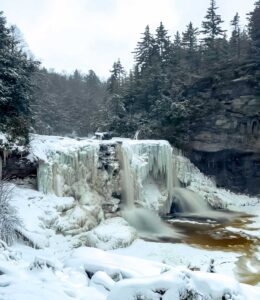
Image by Kris Maria
For outdoor enthusiasts, winter can be a pretty incredible season. The trails are quiet and the mountains beckon us with blankets of glistening snow.
It’s a great time to get a different perspective on familiar trails (sans mosquitos and sweat), but it also comes with its own set of challenges. Ensuring safety and preparedness is paramount to make the most of the winter season’s outdoor adventures.
Let’s go over some key winter safety tips to make sure you’re not the next hiker rescue story!
1. Dress in Layers: One of the cardinal rules of winter hiking is to dress appropriately. Layers are your best friend, helping regulate body temperature and providing flexibility as you traverse through varying conditions. Start with a moisture-wicking base layer, add insulating layers for warmth, and finish with a waterproof and windproof outer shell. Another good rule of thumb is to start “cool” (especially if you’re starting uphill) so you don’t sweat too much. Once that sweat evaporates, it will make you colder, which can be dangerous. Be sure to have layers with you, even if you don’t need all of them! Depending on the temperature range, other important items include gloves, a hat, Merino wool socks, and a neck warmer.

Image by Kris Maria
2. Footwear Matters: The right footwear can make or break a winter hike. Opt for insulated, waterproof boots with good traction. Micro spikes or other traction devices can be a valuable addition for slippery terrains, offering stability and reducing the risk of slips and falls. The exact type of device to add to your feet really depends on the conditions — this is why it is important to check trail conditions in advance. You can use apps like AllTrails for recent reviews, and I always recommend the official website of whoever manages the land you’re hiking on (e.g., U.S. Forest Service, National Park Service, etc.). For packed snow or icy conditions, micro spikes work great. For deep snow, you’ll want to opt for snow shoes so you don’t break through and “post-hole.” Poles are also extremely useful to avoid slips.
3. Plan Your Route: Winter conditions can alter the difficulty of a trail. Plan your route in advance, considering factors such as daylight hours, weather forecasts, and trail conditions. Inform someone about your hiking plans and expected return time, ensuring there’s a safety net in case of unforeseen circumstances. It’s very easy to underestimate the time you’ll need for a snowy hike, and with limited daytime hours, getting caught in the dark can be dangerous. Make sure you have a light source like a headlamp or flashlight (NOT your cellphone), emergency items (more below), and plenty of time to finish your route.

Image by Kris Maria
4. Pack Essentials: Your backpack should always house the 10 essentials, including a winter-specific survival kit. Include items such as extra layers, high-energy snacks, a thermos with hot drinks, a first aid kit, emergency shelter, a map and compass (or GPS; again, not your phone), and a multi-tool. It may be cold, but don’t underestimate the sun. Make sure to have sun safety items such as sunscreen (for exposed skin), sunglasses, and a hat. It’s better to be over-prepared than caught off guard by the elements.
5. Stay Hydrated and Fueled: Cold temperatures may mask the sensation of thirst, but staying hydrated is crucial. Make sure you have plenty of water and bring along high-energy snacks to keep your body fueled. Avoid alcohol, as it can impair judgment and increase the risk of hypothermia.

Image by Kris Maria
6. Be Aware of Hypothermia: Recognizing the signs of hypothermia is vital in winter conditions. Watch for symptoms such as shivering, confusion, slurred speech, and numbness. If someone in your group shows signs of hypothermia, take immediate action by getting them warm and seeking help if necessary.
7. Know When to Turn Back: Winter weather can be unpredictable, and conditions may change rapidly. Know your limits and be prepared to turn back if the weather deteriorates or if the trail becomes too challenging. Safety should always be the top priority. The trail will still be there for you to finish another time. No hike is worth your life! Remember, by risking your own safety, you are also risking the safety of search and rescue personnel who will be deployed to help you.

Image by Kris Maria
Winter hiking opens up a world of tranquility and beauty, but it requires careful planning and preparedness. Winter hiking is not something to take lightly. By dressing appropriately, planning your route, packing essentials, and staying vigilant to signs of danger, you can hit the trails this winter season while ensuring a safe and memorable outdoor experience.
Kris Maria is a hiking and travel blogger based in the Washington, D.C., area. Visit her website, krismariawanders.com, for more East Coast adventure ideas
 Your Privacy Choices
Your Privacy Choices
 The
The